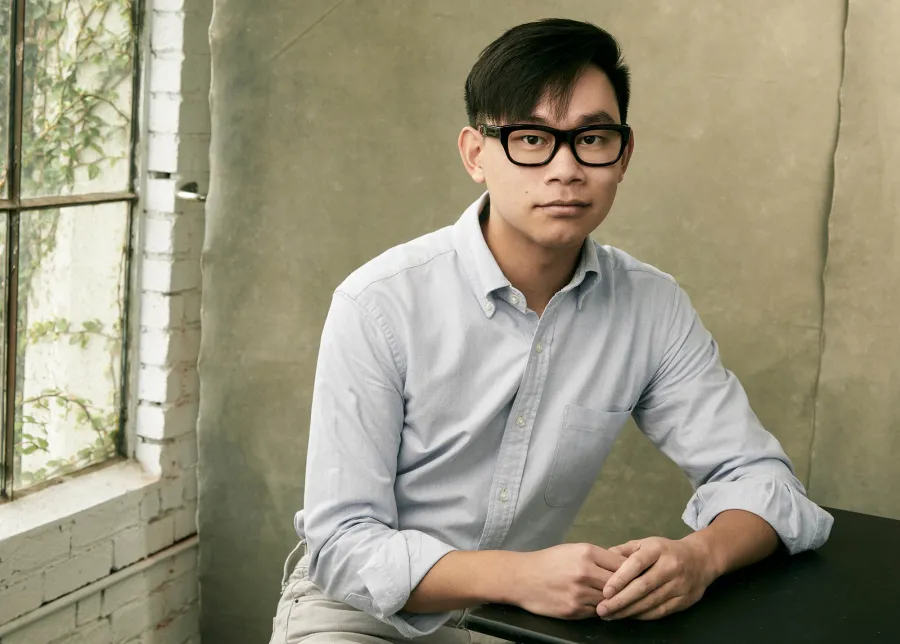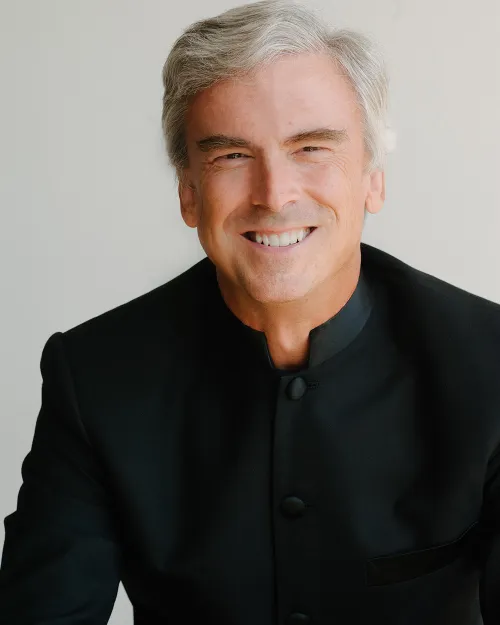
Jerry Junkin, conductor
Jacob Feldman, soprano saxophone
Marina Sakellakis, alto saxophone
Lucy Croasdale, tenor saxophone
Daveid Bennette, baritone saxohone
This concert will last approximately 60 minutes with one intermission
Program
Dmitri Shostakovich, arr. Hunsberger
Festive Overture
Aaron Copland
Emblems
INTERMISSION
Viet Cuong
SECOND NATURE:
Concerto For Saxophone Quartet & Wind Ensemble consortium premiere
Part 1
Part 2
Part 3
Zhou Tian
Sinfonia
Noir
transit
Arioso
D-O-N-E
About the Program
program notes by Mark Bilyeu
Dimitri Shostakovich
Festive Overture, Op. 96
BORN September 25, 1906, Saint Petersburg, Russia
DIED August 9, 1975, Moscow, Russia
COMPOSED 1954 / 1965
PREMIERED November 6, 1954 at the Bolshoi Theatre
DURATION 6 minutes
Composer Dmitiri Shostakovich and his friend and confidant Lev Lebedinsky were relaxing in the composer’s Moscow flat when the conductor from the Bolshoi Theater Orchestra came knocking at the door. A celebration of the 37th Anniversary of the 1917 October Revolution was in three days, and through a series of political and personal missteps (isn’t that always the case?) they did not have a new work to premiere as planned. He begged Shostakovich to write something, and he did. Political missteps were endemic to Shostakovich’s life. He was constantly playing a game of cat-and-mouse with the dictator Stalin and his cultural police. The composer was constantly walking the line between “attempting to share his progressive, anti-authoritarian music” and “not being kidnapped and killed by Stalin” — a fate endured by other outspoken artists of the time. His Festive Overture, however, has none of the angst, bite, or subversive messaging that Stalin hated. As Lebedinsky shared, “The speed with which he wrote was truly astounding. Moreover, when he wrote light music he was able to talk, make jokes and compose simultaneously, like the legendary Mozart. He laughed and chuckled, and in the meanwhile work was under way and the music was being written down.” The work, originally for orchestra, was a hit, and four years later was transcribed for Russian wind bands (including a full battery of saxhorns). Donald Hunsberger later adapted it for American bands (no saxhorns), which is the iteration heard today. Although Shostakovich, who was a notoriously nervous and comically skittish personality, was not a trained conductor, he did conduct one single concert in his entire lifetime: the premiere of his cello concerto, a concert which opened with his Festive Overture.
Aaron Copland
Emblems
BORN November 14, 1900
DIED December 2, 1990
COMPOSED 1964
PREMIERED December 18, 1964, Trojan Band of the University of Southern California, William Schaefer, conductor
DURATION 11 minutes
“In May, 1963,” wrote Aaron Copland, “I received a letter from Keith Wilson, President of the College Band Directors National Association, asking me to accept a commission from that organization to compose a work for band. He wrote:
The purpose of this commission is to enrich the band repertory with music that is representative of the composer’s best work, and not one written with all sorts of technical or practical limitations.’ That was the origin of Emblems. I began work on the piece in the summer of 1964 and completed it in November of that year...Keeping Mr. Wilson’s injunction in mind, I wanted to write a work that was challenging to young players without overstraining their technical abilities. The work is tripartite in form: slow-fast-slow, with the return of the first part varied. Embedded in the quiet, slow music the listener may hear a brief quotation of a well-known hymn tune Amazing Grace, published by William Walker in The Southern Harmony in 1835. Curiously enough, the accompanying harmonies had been conceived first, without reference to any tune. It was only a chance of perusal of a recent anthology of old ‘Music in America’ that made me realize a connection existed between my harmonies and the old hymn tune. An emblem stands for something — it is a symbol. I called the work Emblems because it seemed to me to suggest musical states of being: noble or aspirational feelings, playful or spirited feelings. The exact nature of these emblematic sounds must be determined for himself by each listener.
Viet Cuong
Second Nature:
Concerto for Saxophone Quartet & Wind Ensemble
BORN September 8, 1990, West Hills, CA
COMPOSED 2023
PREMIERED Texas Tech University,Symphonic Wind Ensemble, Aruna quartet, Sarah McKoin, conductor
DURATION 16 minutes
From the Composer:
The term ‘second nature’ typically describes a skill that, while baffling at first, becomes effortless once mastered. Naturally, Second Nature calls for a quartet of saxophonists to tackle the virtuosic demands of the piece and make their efforts look easy. But the virtuosity in their music runs deeper than speedy flurries of notes or sky-high belts. The solo quartet must also play with exacting ensemble coordination as they emulate complex electronic delay effects, which, when combined with thumping four-on-the-floor drumbeats, capture the infectious exuberance of House music. If you see the soloists sweat, I hope that it’s at least in some measure because the music inspires them to move. I personally have never danced so much while writing a piece (and fortunately you’ll just have to take my word for it). Written in three unbroken movements, this concerto often exudes pure, unbridled joy. Indeed, when I think about my own nature as a composer, and the affective inclination of my earlier work, it was at first joy. Improvisation at the keyboard, my first childhood foray into composition, was a happy escape from the labors of piano practice. For many years composition felt like play, and my music was infused with much more whimsy than gravitas. That changed to a great degree in 2020. My compositions, both by intention and the unconscious intrusions of the wider world, became darker and introspective. I had even come to terms with the possibility that my music would remain in this darker place for a very long time. However, with the brightness of its opening and closing C-major chords, Second Nature is me finding my way back. In that way, “second nature” is less of a description of something that has become effortless, but rather something which is relearned, an inclination rediscovered—nature, for the second time around.
*The University of Texas at Austin is a consortium partner of this work
Zhou Tian
Sinfonia for Wind Ensemble
BORN 1981, Hangzhou, China
COMPOSED 2022
PREMIERED April 30, 2022, Michigan State University Wind Symphony, Kevin Sedatole, conductor
DURATION 20 minutes
At the age of 12, Chinese-born composer Zhou Tian was already working as a studio pianist and arranger alongside his father, who worked as composer for Chinese television shows. At the age of 19, Zhou moved to the United States and began his studies at the Curtis Institute, followed by The Juilliard School, and finally at the University of Southern California. He writes:
Sinfonia seeks inspirations from cultures close to my heart and mixes them into four different movements. It begins nostalgically and ends on a hopeful, uplifting note.
I. Noir: Grainy films and stylized black-and-white images from the 1940s and ’50s inspired this nostalgic throwback. Although it starts brightly, at its core lies the night.
II. Transit: New York City. Subway. Rush hour. Each stop opens to a new soundscape. “Say, did I hear Jazz?” Someone asks. “STAND CLEAR OF THE CLOSING DOORS, PLEASE,” New York replies.
III. Arioso: Shanghai. Night of the Mid-Autumn Festival. A vocalise was conceived.
IV. D-O-N-E: May 10, 1869. Promontory, Utah. A one-word telegraph was sent across the United States in Morse code, announcing the completion of the First Transcontinental Railroad. Now the country was connected as never before: a journey between San Francisco and New York that previously took up to six months now took only days. Some 150 years later, that word, “D-O-N-E,” is transformed here into music using the rhythm of the Morse code.
*The University of Texas at Austin is a consortium partner of this work
About the Artists

Jerry Junkin
Serving since 1988 on the faculty of The University of Texas at Austin, where he holds the Vincent R. and Jane D. DiNino Chair for the Director of Bands, in addition to serving as a University Distinguished Teaching Professor, Jerry Junkin is recognized as one of the world’s most highly regarded wind conductors. Previously, he served on the faculties of both the University of Michigan and the University of South Florida. In addition to his responsibilities as Professor of Music and Conductor of the Texas Wind Ensemble, he serves as Head of the Conducting Division and teaches courses in conducting and wind band literature. He has served as Music Director and Conductor of the Hong Kong Wind Philharmonia since 2003, and as Artistic Director and Conductor of the Dallas Winds since 1993. He also serves as Visiting Professor at the Senzoku Gakuen College of Music Wind Ensemble in Tokyo, Japan. Mr. Junkin has conducted All-State bands and festivals in forty-eight states and five continents, and is a Yamaha Master Educator.
Wind Ensemble
FLUTE
Michael Hung
Rebecca Huynh
Nina Robinson
Katie Worsham
OBOE
Ryan Hirowaka
Rachel Marquez
Nadia Para
CLARINET
Daniel Aisenberg
Jacob Bricker
Chase Cano
Connor Gibson
Destiny Lerma
Katelyn Nguyen
Nathan Richey
Hunter Robertson
Mason Smith
BASSOON
Corey Castillo
Jonathan Churchett
Katia Osorio
SAXOPHONES
Ethan Ashley
David Bennette
Lucy Croasdale
Jacob Feldman
Ben Kaplan
Marina Sakellakis
HORN
Chia-Ling Chiang
Daniela Garcia
Ethan Gurwitz
Jonah Hammett
Cheryll Huddleston
TRUMPET
Samuel Acosta
Remy Gilboe
Michael Hawes
Lane Hensley
Tyler Sarver
Emily Tourgeman
TROMBONE
Zach Ailing
Lauren Casey-Clyde
Alvin Ho
Josh Stout
EUPHONIUM
Anthony Gonzalez
Miguel Gonzales
TUBA
Evan Sacks-Wilner
PERCUSSION
Justin Cooperman
Jaime Garcia
Ethan Hall
Marcos Jurado
Reese Maultsby
Caroline Richards
Seth Underwood
HARP
Natalie Rochen
PIANO
Yixua Wang
STRING BASS
Reilly Curren
Upcoming Events
Wind Symphony & Symphony Band
Wednesday, March 20, 7:30 pm
Bates Recital Hall
Wind Ensemble
Sunday, April 14
Bates Recital Hall
Symphony Band
Wednesday, April 24, 7:30 pm
Bates Recital Hall
Wind Symphony
Friday, April 26, 7:30 pm
Bates Recital Hall
Event Details
All University of Texas at Austin students are allowed one free ticket as long as they are available. Student tickets must be picked up at the Box Office with valid student I.D. Seating is unassigned.
If you are a patron with ADA needs, please email tickets@mail.music.utexas.edu and we will reserve ADA seating for you.

